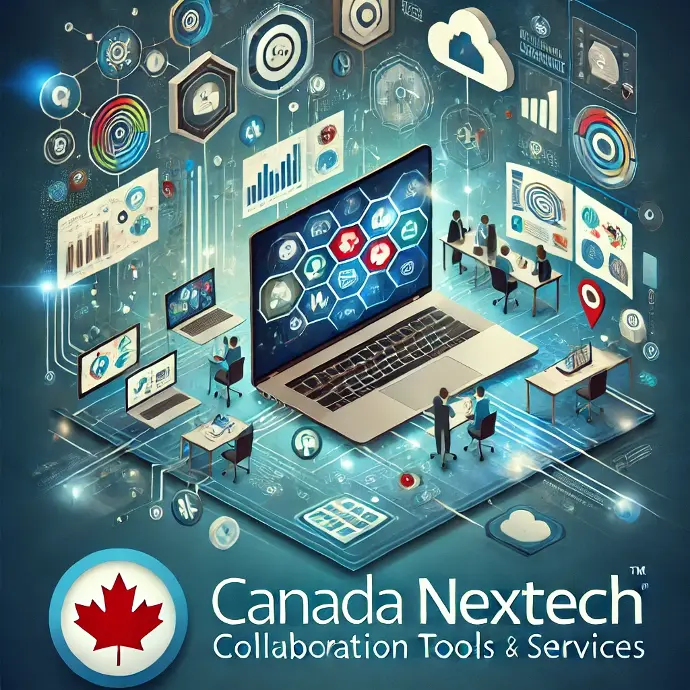Communication Service Overview
In today’s interconnected world, effective communication is vital for business success. Canada NexTech offers a robust suite of communication services designed to enhance connectivity and collaboration across your organization. Leveraging cutting-edge technology and comprehensive service support, we ensure that your communications infrastructure is reliable, secure, and scalable.

Voice over Internet Protocol (VoIP)
VoIP is a technology that allows voice communication and multimedia sessions over the internet, replacing traditional phone lines with a more flexible and cost-effective solution. With VoIP, users can make and receive calls from computers, smartphones, and dedicated VoIP devices. Popular VoIP services like Skype, Vonage, and Google Voice offer features such as call forwarding, voicemail, and even video calling, making it suitable for both personal and business communication. VoIP is especially advantageous for businesses as it reduces telecommunication costs, supports remote work, and integrates with other communication tools.
Instant Messaging (IM)
Instant messaging platforms provide real-time text-based communication between users. These platforms often include additional features such as file sharing, video conferencing, and task management, making them a central hub for team collaboration.


Email
Email remains a foundational tool for formal and asynchronous communication. It is widely used for business communications, marketing, and record-keeping due to its reliability and the ability to archive and organize conversations.
Video Conferencing
Video conferencing platforms allow users to conduct face-to-face meetings over the internet, bridging the gap between remote teams and clients. These tools often include additional features like screen sharing, chat, and recording capabilities.


Social Media Messaging
Social media platforms have integrated messaging systems that enable both personal and professional communication. These tools are often more informal and are used for quick updates, customer service, and marketing interactions.
Collaboration Tools
Collaboration tools combine various communication methods into a single platform, often including instant messaging, video conferencing, task management, and file sharing. These platforms are designed to streamline teamwork, especially in remote or hybrid work environments.

Voice over IP (VoIP) technology enables voice communication over the internet rather than traditional phone lines. By converting voice signals into digital data, VoIP allows users to make calls using a computer, smartphone, or dedicated VoIP phone.
Key Features:
- Cost-effective: Significantly reduces the cost of long-distance and international calls.
- Scalability: Easily scalable for businesses, allowing for the addition of new lines without physical infrastructure changes.
- Integration: Often integrated with other communication tools like video conferencing and instant messaging.
Popular Platforms:
- Skype
- Zoom
- Cisco Webex
Instant messaging platforms provide real-time text-based communication between users. These platforms often include additional features such as file sharing, video conferencing, and task management, making them a central hub for team collaboration.
Key Features:
- Real-time Communication: Enables instant exchange of messages, fostering quick decision-making and collaboration.
- Presence Indicators: Shows the availability status of users, such as online, offline, or busy.
- Security: Most platforms offer encrypted communication to protect sensitive information.
Popular Platforms:
- Microsoft Teams
- Slack
Email remains a foundational tool for formal and asynchronous communication. It is widely used for business communications, marketing, and record-keeping due to its reliability and the ability to archive and organize conversations.
Key Features:
- Asynchronous Communication: Allows recipients to respond at their convenience, making it ideal for detailed or non-urgent communications.
- Attachment Support: Enables the sending of documents, images, and other files.
- Archiving: Provides a way to store and search past communications.
Popular Platforms:
- Microsoft Outlook
- Gmail
- Yahoo Mail
Video conferencing platforms allow users to conduct face-to-face meetings over the internet, bridging the gap between remote teams and clients. These tools often include additional features like screen sharing, chat, and recording capabilities.
Key Features:
- Face-to-Face Interaction: Enhances communication by allowing participants to see each other, improving engagement and collaboration.
- Screen Sharing: Facilitates presentations and demonstrations by allowing users to share their screens with others.
- Recording: Many platforms allow sessions to be recorded for later review or distribution.
Popular Platforms:
- Zoom
- Microsoft Teams
- Google Meet
Social media platforms have integrated messaging systems that enable both personal and professional communication. These tools are often more informal and are used for quick updates, customer service, and marketing interactions.
Key Features:
- Broad Reach: Allows businesses to connect with a vast audience, including customers and partners.
- Multi-Channel Communication: Supports text, images, videos, and links, making it a versatile tool.
- Real-time Interaction: Facilitates immediate responses to customer inquiries or feedback.
Popular Platforms:
- Facebook Messenger
- Twitter Direct Messages
- LinkedIn Messaging
Collaboration tools combine various communication methods into a single platform, often including instant messaging, video conferencing, task management, and file sharing. These platforms are designed to streamline teamwork, especially in remote or hybrid work environments.
Key Features:
- Integrated Communication: Combines chat, email, and video conferencing into one tool, reducing the need to switch between applications.
- Task Management: Includes features to assign, track, and manage tasks within the team.
- File Sharing and Storage: Provides a central location for sharing and storing documents, ensuring all team members have access to the latest versions.
Popular Platforms:
- Microsoft Teams
- Slack
- Asana